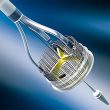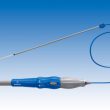Courtesy of Dr. Carlos Fava. Transcatheter aortic valve replacement (TAVR) has been proven to reduce mortality and improve the quality of life of patients with pure severe aortic stenosis (PAS). However, there is a significant number of patients who experience mixed aortic stenosis associated with moderate/severe aortic regurgitation (MAS). These subjects were excluded from the PARTNER...
Small Aortic Annulus: What Valve Should We choose?
Courtesy of Dr. Carlos Fava Surgical aortic valve replacement in a small annulus (<400 mm2) is associated with shorter duration, higher valve deterioration and patient prosthesis mismatch (PPM). They present a negative impact as regards duration and evolution. TAVR might be an option, with superior hemodynamic outcome and lower PPM. Read also: “Patients and Healthcare...
Mitral Valve Repair with MitraClip Is Safe in High-Risk Patients
Courtesy of Dr. Carlos Fava. Transcatheter mitral valve repair with MitraClip has shown good results in symptomatic patients with extreme surgical risk in different studies. However, its “real world” benefits have not been studied in depth due to how complex this strategy is compared with other usual procedures. This study analyzed 2952 patients who underwent mitral...
TCT 2017 | The TRI-REPAIR and the FORMA Trials: New Devices for the “Forgotten Valve”
Courtesy of SBHCI. Two new transcatheter treatments for severe or massive functional tricuspid regurgitation have showed good results at 30 days, according to their feasibility studies. The long-forgotten tricuspid valve has been gaining more attention with research linking tricuspid regurgitation to an increase in mortality. Early studies used devices originally designed for the mitral or...
TCT 2017 | INTREPID: Mitral Replacement with a Self-Expanding Device
Courtesy of the SBHCI. Intrepid is a 43-, 46-, and 50-mm nitinol self-expanding valve with bovine pericardial leaflets that is placed using a transapical delivery system with a 35-Fr access. This pilot study enrolled 50 patients with severe mitral regurgitation who were symptomatic and at a high surgical risk, or in whom surgery was contraindicated. Read...
TCT 2017 | MAVERIC: Results 6 Months After Transcatheter Mitral Valve Replacement
Courtesy of the SBHCI. This seems to be the year for transcatheter mitral valve devices, and the ARTO system tested in this study looks promising for the treatment of patients with severe mitral regurgitation who are symptomatic due to heart failure and ejection fraction <40%. The study enrolled 50 patients who underwent clinical and ecocardiographic follow-up...
New Study Confirms TAVR Durability at 5 Years
The ADVANCE study was designed to evaluate the safety and effectiveness of transcatheter aortic valve replacement (TAVR) with self-expanding prosthesis CoreValve in “real world” patients with symptomatic, severe aortic stenosis at high surgical risk. Patients were enrolled from 44 experimental centers in 12 countries; treatment approach and choice of anaesthesia were determined by the local Heart Team....
REPRISE III: Need for Pacemaker and Paravalvular Leak with Lotus
A recent presentation at London Valves took a closer look at the REPRISE III trial as regards two points that generated much discussion, such as need for a pacemaker and paravalvular leak. REPRISE III had previously demonstrated that the Lotus is noninferior to first-generation CoreValve and Evolut R in terms of safety. Additionally, it proved to be superior...
The need for dialysis after TAVR increases mortality
Courtesy of Dr. Carlos Fava. Stage III or higher renal impairment is frequent before TAVR, and the need for new dialysis after the procedure may reach up to 20%. Within that percentage, 5% may require permanent dialysis, which increases mortality up to 9 times at one year. In that sense, factors leading to that complication have not...
Positive Outcomes of CoreValve Evolut in Large Population
The Evolut R, as well as its predecessor the CoreValve, is a self-expandable valve, supra-annular, made of porcine pericardium in a nitinol frame. Amongst its improvements, it has a better profile and the option to resheath. This makes it fully repositionable and even recapturable. We only needed to confirm these technical advantages would translate into clinical...









